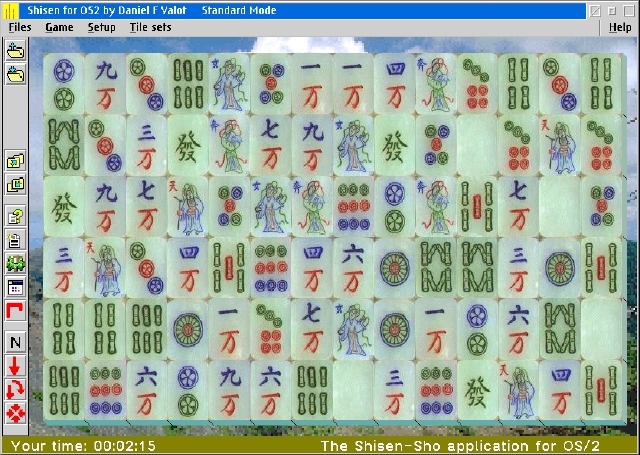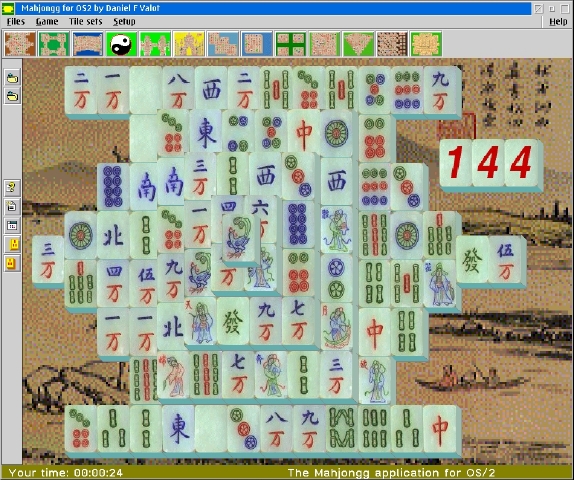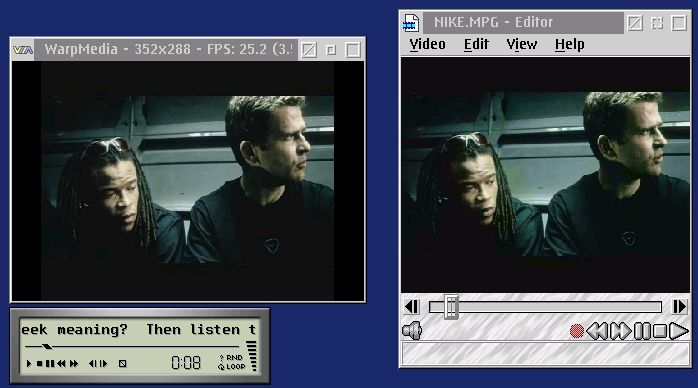


Shisen-sho is a solitaire game based on mahjongg tiles. Just like the "Mahjongg" game included with OS/2, the goal is to remove all tiles from the board, two at a time. The rules of the game are very simple. With only 2 rules, it won't be difficult to remember.

Shisen-sho has a fixed rectangular layout, but the size of the board can be varied from a minimum size of 14x6 to 30x16 tiles. There are also various options to for speed, hints, generating solveable games, etc. There are also 9 quite different tile sets, you can choose whatever one pleases your eye.
Shisen-sho comes in a .ZIP, which you just unzip into the directory of your choice. The whole bundle will set you back almost 2MB worth of disk space. A SETUP.CMD script is provided, which will create an icon on your desktop if you wish. I didn't encounter any great problems when I played. However, I did notice that on my system at least (and I know it has rather unique video, it's a 13.7" laptop LCD that does 1280x1024 without panning), some tile sizes in conjunction with certain window sizes produced black lines between the tiles. While annoying, I was able to work around this by re-sizing my window until the black lines disappeared or by selecting a larger/smaller layout. If you enjoy solitaire type "card" games, Shisen-sho will add some welcome variety for your enjoyment, especially since it is free. (The license though, is a bit confusing. The included license file says that it is neither shareware or freeware, but you can download it for free from the authors web site. Hmm...) The author seems to be actively developing Shisen-sho, and you can find him on the Usenet groups occasionally. One "drawback" to this active development is that he releases fixes/updates at a rate of what seems like one a week!
Curiously enough, Shisen-sho does have a "competing" product Shisen/2. Judging by the screenshots on the author's web site, it looks a bit more slick, and is available in a free "standard" version as well as a shareware "pro" version. Unfortunately, I had some problems getting it running and ready in time for the review.
Mahjongg for OS/2 obviously grew from the same code as Shisen-sho. The rules are pretty much the same as "Mahjongg" that came with OS/2. (And as an aside, all these "Mahjongg" games are as much Mahjongg as solitaire is poker. They merely use the same tiles).

Installation is identical to Shisen-sho, just unzip into the directory of your choice, and (optionally) run the SETUP.CMD script to create an icon on your desktop. You'll need about 2MB free space to hold all the files.
Mahjongg for OS/2 has exactly the same tile set options as Shisen-sho (the "original" Mahjongg with OS/2 has 2 tile sets). The board size isn't directly configurable, but several "missions" or board layouts are available. Oddly enough, I didn't get any of the video problems that I experienced with Shisen-sho.
If you're happy with the original Mahjongg bundled with OS/2, you'll be happy with this one, since it's virtually the same game. While it lacks the funky opening video, you do get a much more varied selection of tile sets and some confidence that it's still under active development! As with Shisen-sho, it is freely downloadable from the author's web site.
This is the last, and quite possibly the most polished OS/2 game released by Stardock. It is roughly similar to "xtrek", which is a network game that's been around forever on UNIX, so the concept is pretty proven. "xtrek" was wiped and completely banned from the entire engineering department where I studied because it chewed up so much bandwidth! It was too popular!
Stellar Frontier is only available as a download, weighing in at ~10MB. The download is an executable which will perform the installation. It's very slick looking. It unpacks everything it needs and cleans up after itself too. Expect the full install to take close to 22MB of disk space. You get to choose the destination directory (always a good thing), and afterwards, it creates a folder on your desktop which contains the game itself, the server, documentation, various URL links and an uninstall program as well.
This is not a game where you can just fire it up and start shooting! Well, you could, sort of, but I highly recommend you read the documentation first, as there are a lot of commands and functions that are available to you. The basic goal of the game is to colonize the universe and blow up anyone who gets in your way. The more people you blow up, the more credits you get towards upgrading your ship. (And we all know how addictive collecting stuff and upgrading is...Diablo anyone?) Of course, tose people you are trying to blow up want to do precisely the same thing to you! And while you're worrying about that, don't forget about colonizing planets either...
Now, perpetually fighting the computer might not be so fun after a while, but this (like xtrek and Diablo) is an on-line game. You get to fight on-line against other real players, and optionally, your character's stats can be stored on Stardock's servers. Lemme tell you, there's nothing quite like the satisfaction you get from blowing up your best buddy more times than he can shaft you!
Anyway, more about the game itself. You won't probably won't be playing this on any of your old i486 class machines, that's for sure! With so many ships and items to keep a track of, Stellar Frontier seems to like horsepower. I played it just fine on a PII-300MHz laptop, even on giant 1280x1024 screen size, but with some tweaking (Stardock recommends you run 256 colour mode for best results, I ran in 65k colour mode), you could minimize the requirements further. Even at 256 colours, the graphics are excellent! For this type of game, I don't think it looks dated, who says you can't have great looking fun under OS/2?

After the opening "Stardock presents..." screen (complete with requisite sound "logo"), you get this main screen with a bunch of options. For beginners, I'd recommend playing against the computer first before going on-line. Other options include sound and music. The sound is turned on by default (of course!), but I'd recommend you don't activate the music if you run a slower system, on my laptop, my poor little game of Stellar Frontier nearly stopped it was so slow. However, it seemed fine when I tested it on a desktop PIII-600MHz machine.
When you first start, you'll need to create a character. You'll be asked for the name, race (Terran, Drengan, Arcean or Pirate) and the ship you start off with. Once game play starts, you'll magically appear within range of your home planet and space colony. Now go! Start colonizing and blowing the "enemy" to smithereens! I wouldn't worry about taking too many risks early on when you're learning the game, if you get blown up, you simply get "re-incarnated" at your home planet. And you'll get blown up a lot before you get the hang of it. Just like real spaceships, you can't turn on a dime or stop instantaneously. There's this thing called momentum built in, you see. Just navigating can be a bit tricky, but try that while locking on to your target and firing off missiles at the same time! Fortunately, it's not too tricky to be a turn off. I think it seems to stride that magical line where you are always thinking "Okay, just one more time I'll have it mastered!" but of course, you'll be wrong.

You can play the computer, on your own mini-network (intranet) or over the Internet with players from all over the world. One problem with playing over the Internet is that there is always some "idiot" who cheats or flies around blowing new players out of the water with overwhelming fire power. In general, these seem to be dealt with on an individual case by the community somehow. But don't let those little issues stop you from playing. It can get quite addictive. There's much more to this game than I can get into for a mini-review! The best thing to do is to get the game yourself from Stardock and give it a spin, because the entire game, including on-line play is FREE. That's right, available at no cost! There is an upgrade ("Admiral's Club") available for purchase which gets you some extra ships and weapons if you want to support further development, but the free version is perfectly fine. If you really want the "full" version of Stellar Frontier, you can also buy it as a part of eComStation (http://www.ecomstation.com).
You can download Stellar Frontier free of charge from Stardock's (http://www.stardock.com) Stellar Frontier Home Page (http://www.stardock.com/products/sf/).
The programmers who brought you WarpAmp seem to have gone back to the drawing board and come out with the Warpmedia Player. Not only does it play MP3's, it will also handle all sorts of video formats, including DivX;-). (Which, in my opinion, has got to be one of the stupidest names for a video codec ever. Almost the same name as a much-hated, and now defunct DVD format, and it includes the smiley as part of the name).
It is still officially in beta. While this makes me worry a little bit (as WarpAmp never got past Beta4), it, like WarpAmp, is very useable in its current form already. I didn't notice any problems playing MP3's or any of the MPEG's I tried. However, in some cases, I know that there are sound/video syncing problems still to be ironed out. However, I'll still go out on a limb and declare that the Warpmedia player, it its current form, is a far better MPEG player than any other existing (and available) MPEG player for OS/2.
Warpmedia player supports skins (including non-rectangular ones) and handles MP3's as well as all sorts of video formats. I'm personally not too concerned with the eye candy, or its MP3 capabilities. (Afterall, we still have 2 very good MP3 players, Z! (http://dink.org)(which is free) and PM123 (http://www.cam.org/~guardia/pm123.html) (which is shareware). What interests me most is the MPEG video capabilities. The latest MPEG player for OS/2, which comes as part of the Netscape 4.61 Plug-in Pack, is unstable, CPU intensive and exhibits poor video quality. (In all fairness, I think it was really only meant to be a sample or demo, not the MPEG player for OS/2.)
Even in beta mode, Warpmedia really shines at MPEG video. First off, the picture quality is excellent, equivalent to the best I can muster in Win95/98 (including players specially optimized for my video card.) Secondly, it seems very stable. I've never had it lock up my system, even playing full screen. And finally, it's efficient! On my PII-300MHz laptop, it seems to be able to handle full screen 1280x1024 without any noticeable problems. Very nice!

This is a screen shot of Warpmedia player in action right next to the OS/2's MPEG video player. This particular video I chose is quite friendly to OS/2's MPEG video player in that it looks relatively decent and plays without too much trouble. Even in this "best" case, look closely at the actor's face (actually, it's not an actor, they're real footballers, soccer to you Americans) and you can see the quality difference. (Those of you running 1024x768 or more might be find it hard to see. Try zooming in 2x). If you try doing something in the background or playing full screen and the advantage of WarpMedia becomes blatantly obvious. Oh, and the full screen mode really is full screen, no title bars or anything.
Warpmedia player is highly useable, even though it's still in beta. Not only can it handle audio MP3's, it can handle a variety of video formats as well, including MPEG and DivX;-). If you can access the MPEGAV directory of VideoCD's (or use Tonigy CDFS (http://www.tonigy.com), you can play VideoCD's as well. There are a few bugs to be ironed out yet, but it is already an excellent player with top video quality, efficient CPU utilization and is stable to boot. And it won't cost you a cent! The full package, installed, including the development kit and some sample skins, comes in at less than 2.5MB of disk space.
Warpmedia player is freely downloadable from the Software Developers Guild (http://www.sdg.os2.nu/). Also at the site are some skins and a development kit to create your own skins and plugins. Don't forget to first get the base package and then the update. It includes the player, the "development kit" as well as sample skins (new Warpmedia skin, WarpAmp and WinAmp skins).
This article is courtesy of www.os2ezine.com. You can view it online at http://www.os2ezine.com/20010816/page_2.html.